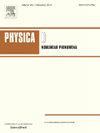Multilayer structure-induced collective dynamics in uncoupled memristive Rulkov neurons: Impact of field coupling and intralayer connections
IF 2.7
3区 数学
Q1 MATHEMATICS, APPLIED
引用次数: 0
Abstract
In this study, we explore a multilayered structure in which the coupled oscillators of one layer serve as a shared medium for an uncoupled population of neurons. The layers function based on the memristive Rulkov map, and interlayer connections are established through magnetic flux variables, referred to as field coupling. We adopt both hybrid (electrical and chemical) and exclusively chemical couplings for intralayer connectivity. The study highlights the pivotal role of the reversal potential in the dynamics of chemical coupling, while the firing threshold and sigmoid slope play lesser roles. Synchrony analysis reveals distinct synchronization behaviors between the layers. Notably, although the coupled layer can achieve phase synchrony, it fails to induce comparable synchrony in the uncoupled layer. Our findings also highlight the emergence of distinct collective dynamics in the uncoupled network, influenced by the coherence level of the flux variables in the coupled layer. Specifically, incoherent, two-clustered, and globally synchronized oscillations of flux variables in the coupled layer lead to chimera states, two-cluster synchronization, and complete synchronization in the uncoupled neurons, respectively.
非耦合记忆性Rulkov神经元中多层结构诱导的集体动力学:场耦合和层内连接的影响
在这项研究中,我们探索了一种多层结构,其中一层的耦合振荡器作为非耦合神经元群体的共享介质。层的作用是基于记忆的Rulkov映射,层间的连接是通过磁通变量建立的,称为场耦合。我们采用混合(电和化学)和纯化学耦合来实现层内连接。该研究强调了反转电位在化学耦合动力学中的关键作用,而放电阈值和s型斜率的作用较小。同步分析揭示了层之间不同的同步行为。值得注意的是,尽管耦合层可以实现相位同步,但它无法在非耦合层中诱导类似的同步。我们的研究结果还强调了在非耦合网络中出现的明显的集体动力学,受耦合层中通量变量的相干性水平的影响。具体而言,耦合层中通量变量的非相干振荡、双簇振荡和全局同步振荡分别导致非耦合神经元的嵌合体状态、双簇同步和完全同步。
本文章由计算机程序翻译,如有差异,请以英文原文为准。
求助全文
约1分钟内获得全文
求助全文
来源期刊

Physica D: Nonlinear Phenomena
物理-物理:数学物理
CiteScore
7.30
自引率
7.50%
发文量
213
审稿时长
65 days
期刊介绍:
Physica D (Nonlinear Phenomena) publishes research and review articles reporting on experimental and theoretical works, techniques and ideas that advance the understanding of nonlinear phenomena. Topics encompass wave motion in physical, chemical and biological systems; physical or biological phenomena governed by nonlinear field equations, including hydrodynamics and turbulence; pattern formation and cooperative phenomena; instability, bifurcations, chaos, and space-time disorder; integrable/Hamiltonian systems; asymptotic analysis and, more generally, mathematical methods for nonlinear systems.
 求助内容:
求助内容: 应助结果提醒方式:
应助结果提醒方式:


